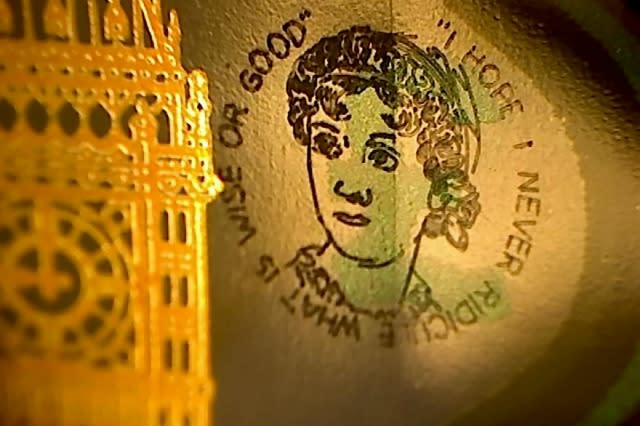Is your £5 note worth £50,000? What should you look for?

You can stop keeping your eye out for low serial numbers on your new plastic £5 notes - in the vague hope that someone might buy it off you for more than £5 - and start checking for four specific serial numbers which are said to be worth a staggering £50,000.
See also: 10 surprisingly valuable coins in your wallet: the ones you don't know about
See also: Is your new Churchill fiver worth hundreds of pounds?
See also: Cheeky eBay sellers asking thousands for 'upside down' £5 notes
Artist Graham Short has engraved a tiny portrait of Jane Austen on just four of the new fivers - surrounded by different quotes from the author. Normally Short's work sells for £50,000-£100,000, and these notes have been insured for £50,000 each. The gallery behind the project has called them 'Willy Wonka's Golden Tickets'.
The artworks were done to mark the 200th anniversary of the author's death next year, and the idea was to encourage more people to be interested in art. It has certainly stirred up some interest - although perhaps the focus is more on the cash than true art appreciation.
How can you find them?
The plan was to spend one note in England, one in Wales, one in Scotland and one in Northern Ireland. So far Short has spent three of them. He used one to by his lunch in Blackwood in Wales, one at a bakery in Kelso, Scotland, and a third in a pie shop in Melton Mowbray. He will spend the fourth in Northern Ireland.
He picked the bakery because he had just launched a new art collection in Kelso, the cafe in Blackwood because that was where his mother was born, and the pie shop because it seemed quintessentially English.
So far, none of the original shops have picked up on their fantastically valuable note. As Stephen Hallam, from the Dickinson and Morris Ye Olde Pork Pie Shoppe said, the fact that he hadn't found the note should be evident from the fact that: "I'm still here making pork pies... I'm not flying off to Barbados."
They have therefore been given out in change. In all probability they will stay fairly local for the first exchange or two, and then will start to travel across the country. If you want to use the location to track a note down, therefore, you'll need to be quick.
What should you look for?
The other thing to bear in mind is that these engravings are really tiny. From some angles you can't see it at all - it has to catch the light in the right way. Short produces the engravings using a microscope, so in order to spot them, you will need very keen eyesight - or a magnifying glass.
Alternatively, Short has revealed details of the serial numbers, which might be easier to check:
AM32 885551
AM32 885552
AM32 885553
AM32 885554
If you find one of the notes, you should contact the Tony Huggins-Haig Gallery, which launched the project, and should be able to get the value from your lucky find.
Alternatively, you can do what plenty of people will already have done - spend the note. The good news is that while Short has technically broken the law by defacing a note, you won't be breaking it by spending it - as it's still legal tender. On the downside, of course, you will just have missed out on £49,995.




